If you are reading these rules for the first time, ignore the text along the right hand side. These rules serve as a summary to help you quickly familiarize yourself with the game.
Setup
Lay out the game material according to the figure below.
Each player selects a color and takes the following:
- the tableau
- the windrose
- the ship
- the 2 discs
- the 12 ownership markers
- 5 gold coins
Place the game board in the middle of the table. It shows the city of Macao,
divided into 30 quarters and surrounded by a city wall (with 16 spaces). Beyond the
wall is the ocean with eight European ports (the targets for the trade from Macao)
and spaces for the ships. On the left is the tribute track (with spaces from 0 to 12).
At the edge of each of the long sides are places for the 24 office cards. Around all
of this runs the scoring track for the players' prestige points (with spaces from 0 to 99).
Note: the map is not an accurate depiction of the city of Macao in order to have room for
the various mechanics of the game.
Each player chooses a color (orange, white, yellow or brown) and takes the following in his chosen color:
-
the tableau, which he places near him on the table (his play area).
On the left side is a brief overview of the play of a game round. It
also has places for up to five cards and for ware tiles and ownership/punish markers.
-
the windrose, which he places next to his tableau.
The 7-sided windrose shows pictures of dice from 1 to 6 and a pointer.
-
the ship, which he places on one of the ship slips (with anchor).
-
two discs, which he places on the 0 space of the prestige point track and on the first space (with a pointer) of the city wall.
The players stack them in two small stacks).
-
12 ownership markers, which he places near his tableau with his color side up.
On the back side of each ownership marker is a punish marker ("-3"). If the marker is placed with the "-3" side up,
it is considered to be a punish marker, which deducts 3 prestige points from the player's score.
-
In addition, each player takes 5 gold coins, which he places next to his tableau
A player must always place his coins so that others can see how many he has.
Place the remaining gold coins next to the game board as a bank.
Sort the 300 action cubes by color and place them next to the game board.
Place the 24 ware tiles randomly (shuffle them and place them as they are drawn) on the houses of the 24 light city spaces and
the 6 joker tiles on the houses of the 6 dark city spaces.
When placing them make certain that the tax stamps are recognizable.
Separate the 120 cards into two stacks based on the different graphic designs on their backs:
-
Shuffle the 24 office cards. Place them in sets of two cards each
face-up next to the long sides of the game board (the board has marks and numbers showing where to place them).
In this way the office cards also serve as round counters.
-
Shuffle the 96 building/person cards and place them face-down in a stack next to the board next to the first two office cards.
Place the two beige discs to the right and left of number "0" on the tribute track on the left side of the board.
The players choose one player to be the dice roller. He takes the 6 dice and places them next to his tableau.
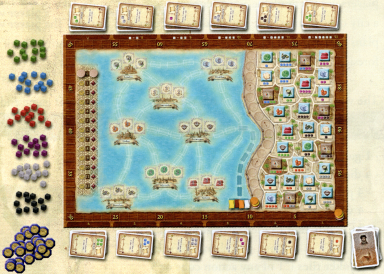
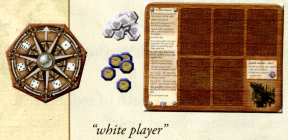
Before the first round:
-
In reverse wall order, each player chooses a B/P card and puts it on his tableau.
-
In forward wall order, each player places 1 and then 2 AC next to the first two spaces of his windrose.
Before the first round the players must do two more things:
-
From the Building/Person card stack, draw two more cards than the
number of players (e.g. 5 cards with 3 players) and place them face-up near
the game board. Beginning with the player whose disc is on the bottom of the
stack of discs on the wall and continuing with the other players in the
order of the discs from bottom to top, each player takes a card and puts it
on any empty card space on his tableau. Place the two unchosen cards
on a discard pile next to the supply stack.
The order of selecting cards is intended to balance the disadvantage of
having a disc lower down on the stack on the wall at the beginning of the
game. For number 2 below and during the rest of the game, the normal turn order
is front to back along the wall and top to bottom within a stack.
-
Starting with the player whose disk is on top of the stack of discs
on the wall and moving downward in the stack, each player takes any
one action cube (AC) from the general supply and places it next to the
1 die space on his windrose and then places any two ACs (of the same
color, but not necessarily the same as the first cube) from the general supply next to the 2 die space on his windrose.
Example: the first player places 1 green and 2 red ACs next to his 1 and 2 die spaces.
The second player places 1 green and 2 green ACs next to his 1 and 2 die spaces.
The third player places 1 black and 2 red ACs next to his 1 and 2 die spaces.
The fourth player places 1 and 2 blue ACs next to his 1 and 2 die spaces.
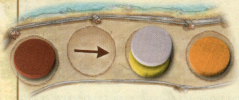
In this example, the player sequence is:
1. Orange, 2. White, 3. Yellow, 4. Brown
Game Play
PLAYING THE GAME
The game is played for exactly 12 rounds. Each has the same flow.
1st phase: cards
1.1) 4 B/P cards face up next to the current 2 office cards
1.2) tribute table values determined and marked
The game lasts for exactly 12 rounds, with each round containing the same phases:
1st phase: cards
2nd phase: dice
3rd phase: actions
→ 1st phase: cards
1.1) First, the dice roller takes the 2 office cards for this round and places
them face up next to the board. Then he draws from the stack and places
the four topmost building/person cards (B/P cards) face up next to the two
office cards for this round.
1.2) Next, the tribute value is calculated. To do this the players add all
yellow numbers in the bottom left hand corner of the six face up cards
and place a beige disc on the left side of the tribute table on the sum
(possibly zero). Similarly, the players add the
red numbers in the lower right corners and place a beige disc on the sum
(possibly zero) on the right side of the tribute table. The tribute table
shows the number of gold coins (GC) a player must spend to buy a number of
prestige points (PP).
Example: with the following 6 cards the tribute table shows that
a player can spend 3 gold coins to buy 6 prestige points.
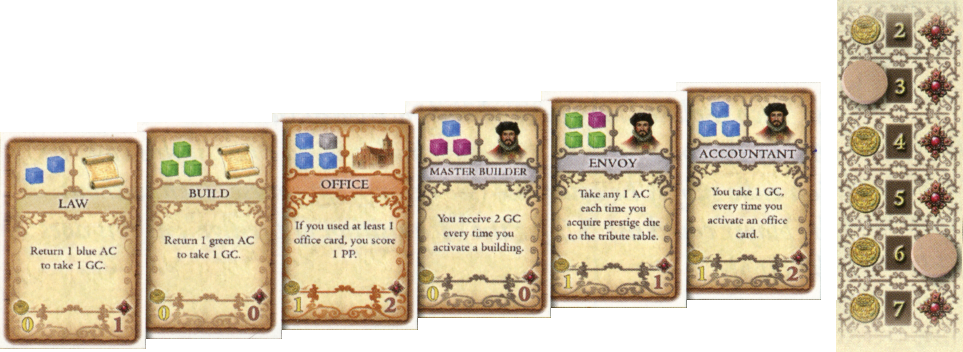
1.3) Remove the last 0, 1 or 2 B/P cards for 4, 3 or 2 players
1.4) In wall order each player must take one card and place it on his tableau
(exception: Idler)
If tableau already full discard a card and take a punish marker
1.3) Discard the 0, 1 or 2 last drawn B/P cards for a 4-, 3- or 2-player game, respectively.
Office cards are not removed.
1.4) The first player on the wall must choose one of the face up cards
and place it on his tableau. This card is reserved for this player (see point 3.1 below).
Then the other players in turn order each choose a card and put it on
their tableaus. After all players have taken a card, discard the two remaining cards.
Notes:
- The activated Idler card changes the preceding rule.
- The players may search through the discard pile at any time.
If a player's tableau contains five cards when he acquires a sixth card, he must discard
any one of his now six cards so that he has only five cards in his tableau. As a consequence,
he receives a punish marker, i.e. he turns one of his ownership markers over so the -3 is showing
and places it in the space provided on his tableau.
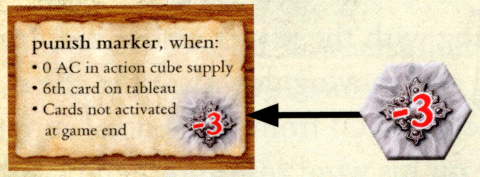
2nd phase: dice
2.1) Roll all 6 dice and sort by number of pips
2.2) Each player selects 2 of the 6 dice and places AC corresponding to the pips of each die
next to the sector of his windrose corresponding to the pips
→ 2nd phase: dice
2.1) The dice roller now rolls all six dice and arranges them so that all those
with the same pips showing are together: all 1s, all 2s together etc.
2.2) Subsequently, the players take turns in wall order*. Each chooses any
two dice (not taking them) and takes the numbers of action cubes of that
color from the supply and places them next to the number matching the
pips on the die on his windrose.
Example: the dice roller rolls a red 2 and
a green 5 among others. A player who chooses these two dice
takes 2 red AC, placing them next to the sector of his windrose
containing a white 2 die, and 5 green AC, placing them next
to the sector of his windrose containing a white 5 die.
* Note: the players may choose to execute this phase simultaneously, choosing their
two dice and taking the AC at the same time. However, if one or more players want to see
what others choose before making their choices, the phase is played in turn order.
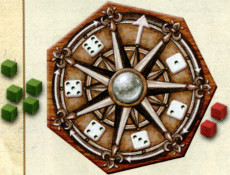
2.3) Next each player rotates his windrose one sector clockwise;
arrow points to a player's "action cube supply"
2.3) After the players take their ACs, each rotates his windrose one sector
clockwise. Thus, each of his AC piles is now next to a sector with 1 fewer pips.
The AC pile which the arrow now points to, i.e. the pile that had been next to
the 1 sector, becomes the player's "action cube supply", which he may use
when executing actions during the 3rd phase of the current round. All other AC piles
are for future rounds and may not be used during the current round.
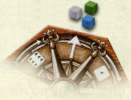
If after rotating his windrose there are no AC next to the arrow sector,
the player receives a punish marker.
If after rotating his windrose the arrow points to a space containing no ACs,
the player receives a punish marker. He turns one of his ownership markers over
so the -3 side is showing (as above). Having activated cards that will add one
or more ACs to his action cube supply during the 3rd phase does not prevent
a player from taking a punish marker.
3rd phase: actions
Use AC for actions in wall order
→ 3rd phase: actions
During the actions phase the players execute actions using their action cube supply.
Players should try to use their action cube supply since a player must return any unused
cubes to the general supply at the end of the phase, i.e. a player may not save any ACs
in his action cube supply for use in later rounds.
The player first on the wall begins and uses (if possible) his action cube supply to execute the
following actions in any combination and order. Then the second player on the wall
does the same, and so on, until all players have taken their turns executing actions.
3.1) Activate cards:
Pay the AC shown on the card to activate it. Move it from the player's tableau
to his play area
3.1) Activate cards (specific AC colors required)
In order to use a card on his tableau a player must first activate it by paying
the AC that are shown at the top of the card from his action cube supply back
into the general supply. Then he
takes the card from his tableau and puts it in his play area. The card is now
activated for the remainder of the game and may be used "free of charge",
including in the round in which it was activated.
A player may activate as many of his cards in his turn as he wants and has
the required AC in his action cube supply for. He can activate cards, do other
actions, and then activate more cards, as he chooses.
3.2) City quarter:
To take possession of one city quarter the player must pay the AC shown
in the city quarter. He then exchanges the ware or joker tile in the city quarter
for one of his ownership markers
Place acquired ware tiles on the "ship" shown on the player's tableau.
Place joker tiles in the player's play area
3.2) Take possession of one city quarter (specific AC colors required)
The city is divided into 30 quarters. At the beginning of the game a ware tile or
joker tile is placed in each quarter.
To take possession of a quarter a player must put the AC shown in the quarter
from his action cube supply back into the general supply. Then he exchanges the
tile in the quarter for one of his ownership markers.
(At game end each player
will score points for his largest group of connected ownership markers in the city.
See game end.)
Once a quarter has been taken by a player, his ownership marker remains in
the quarter for the rest of the game. That quarter cannot be taken again.
The player places the ware tile on the picture of the ship on his tableau so that all
players can see it. This ware is now on that player's ship regardless of where
his ship is.
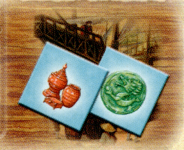
A joker tile can be used either as any 1 AC or as 3 GC
When a player takes a joker tile, he places it next to his
tableau. He can use it at any time during the game, including
immediately after he gets it, to either take any one AC from
the general supply into his action cube supply or take 3 GC
from the bank. After using a joker he discards it next to the game
board out of the game.
Remember: a player may take possession of only one city
quarter in each round.
Note: the cards Jester, Herald, Nightwatchman and
Speculator change the preceding rules.
The Jester for example doubles each joker tile so that each can be
used to take 2 AC, 1 AC and 3 GC, or 6 GC.
3.3) Wall:
Once for 1/3/5/7/... AC of any colors a player may move his disc
1/2/3/4/... spaces along the wall
3.3) Move forward on the wall once (any AC colors)
A player can move his disc forward along the wall once per round.
To move 1/2/3/4/... spaces along the wall the player must pay 1/3/5/7/... AC
of any colors to the general supply. If a player moves his disc to a space
containing one or more other discs, he puts his disc on top.
Notes:
- In the rare case that a player pays enough AC to move his disc to or beyond the
last space on the wall, he places his disc on the bottom of the stack if there
are other discs there.
- The Tower card changes the preceding rules.
3.4) Ship:
For 1/2/3/4/... AC of any colors a player may move his ship
1/2/3/4/... spaces
3.4) Move ship (any AC colors)
A player may move his ship
as often and as far, with any number of direction changes
as he wants along the sea and port spaces. For
each space he moves his ship (each port counts as a space) the player must
return one AC of any color from his action cube supply to the general
supply. Any number of ships may occupy a sea or port space.
When a player's ship is in a port and the player has wares on his ship that
are wanted by the port, he can deliver them and score PP for the delivery
When a player's ship is in a port. he may deliver any ware tiles he has on
his ship that match the ware wanted by that port. He places the tile(s)
on the highest empty space(s) available at the port. Then he moves his
disc on the prestige point track to record the points scored (the number(s) on
the space(s) where he placed the ware tiles).
(Delivering wares does not cost the player any ACs.)
Notes:
- If a player's ship is in a port that wants a ware tile that he just acquired by
taking possession of a city quarter, he may immediately deliver the ware and
score prestige points as usual.
- A player may deliver wares any time his ship is in the port that wants them,
not only when he first moves his ship there.
-The Cooperage and 8 storage cards award additional PP for delivering wares.
PP awarded for the Cooperage are NOT doubled by the storage cards.
3.5) Acquire prestige:
Once per turn a player can buy PP for GC based on the tribute table
3.5) Acquire prestige points once (paid for by GC, not AC)
Once per round a player can acquire prestige points by buying them
with GC. The GC purchase price and number of PP received is defined by the
current position of the discs on the tribute table. The player pays the required GC
to the bank and moves his disc on the prestige track accordingly.
Note: the Diplomat and Embassy cards change the preceding rule.
3.6) Use cards:
A player may use his activated cards in whatever order he chooses
(in general, each card may be used only once per round)
3.6) Use cards
On his turn a player may use the function of any number of his activated
cards. He may use them at any time during his turn and in any order, although some functions
are possible only at certain times.
Page 8 shows how the 120 cards are structured and the basic rules for their use.
3.7) Pass:
When a player cannot or chooses not to take more actions, he returns all AC in his
action cube supply to the general supply
3.7) Pass
When a player cannot or chooses not to perform more actions in a turn and still has AC in
his action cube supply, he must return all those AC to the general supply.
Example of a turn: a player might first activate one or more cards, then move his ship
(and use cards related to ship movement), use other cards, take possession of one
city quarter (and use related cards), activate more cards, move his ship again, and
finally acquire prestige (and use related cards).
All combinations and sequences are allowed, but remember that three actions are
allowed only once per round per player: moving forward on the wall, buying PP for GC
based on the tribute table, and taking possession of a city quarter.
Rule notes
Toward the end, all 6's become 1's, then all 6's and 5's become 1's, then all 6's. 5's and 4's, etc.
→ Dice phase:
Beginning with the 8th round, fewer die values correspond to remaining rounds.
Therefore, in the 8th round all rolled 6's are changed to 1's; in the 9th round
all 6's and 5's are changed to 1's, and so on. In the 12th round all rolled dice
are automatically 1's. To remind players of this, dice to change to 1's are shown
on the game board near where the office cards are placed.
Game materials are unlimited
→ Limitations:
No components (action cubes, ownership markers and gold coins) should be limited.
In the rare case that some of these become exhausted, replace the component with
a suitable alternative.
The cards
EACH CARD
indicates:
1) its activation cost (1 to 4 AC)
All 120 cards are structured as follows:
1) At the top left the card displays the exact number and colors of AC
that a player must pay to activate the card. The activation costs vary
between 1 and 4 AC in a variety of color combinations.
2) its kind (office, building or person)
2) At the top right is a graphic which indicates the kind of card it is:
office, building or person.
3) Under these is the name of the card with a different background color
for the three card types. Below the name is text which describes what the card does.
4) its tribute value (between 0-0 and 2-2)
4) At the bottom of the card are two numbers, left and right, which show
the card's exchange rate values for the tribute table. The numbers vary among
0-0, 1-1 and 2-2 (20 each) and 0-1 and 1-2 (30 each). The average exchange rate
is 3 GC for 5 PP. The average total tribute table values for a round are the
GC from the round's two office cards plus 3 and the PP from the round's two office
cards plus 5.
5) Between these two numbers is an indication of when the card can be used.
If nothing is written then the card can be used in the 3rd phase. Otherwise
text will indicate when it can be used (1st or 2nd phase, or at game end).
There are 24 office, 44 building and 52 person cards
The 24 office cards are designed such that the activation cost is evenly
distributed among the colors red, blue, green, gray, violet and black with
four of each color showing 1 to 4 like-colored AC each.
The 44 building and 52 person cards also have activation costs of 1 to 4
AC each but with a variety of like and different colored AC.
Basic rules:
- Only activated cards may be used
- In most cases each card may be used at most once per round
- Most cards are used in phase 3
- A card may be used immediately after being activated
The basic rules for use of all 120 cards:
- A player may only use activated cards. Cards on a player's tableau
have not been activated and cannot be used.
- Each card may be used at most once per round to do what
is described on the card unless the card explicitly says otherwise (e.g.
"whenever" or "every time").
- With few exceptions, cards are used in the 3rd phase (actions phase) when
the owner of the card is taking his turn.
For cards that are not used in the 3rd phase there is text along the bottom
of the card describing when it can be used.
- Once activated, a card may be used immediately, even in the round
in which it was activated.
The abbreviations mean:
AC→ action cube(s)
GC→ gold coin(s)
PP→ prestige point(s)
- Cards use the following abbreviations: AC for action cube(s),
GC for gold coin(s), and PP for prestige point(s).
- When a card directs a player to take AC, he always takes them
from the general supply and places them n his action cube supply.
When a player pays AC he always takes them from his action cube
supply and places them in the general supply.
Implementation notes for particular cards
ARTISAN "You don't have to pay the cost to activate one card,
but you must have the necessary AC in your supply."
Unlike the Archive, Count, Crane and Healer, the Artisan can be used
only once per round.
The player must have all AC shown on the card he applies the Artisan to
even if he also has the card (Archive, Crane or Healer) which would
reduce the AC he would have to pay to activate the card.
CAPTAIN "Score 1 PP if you have moved your ship at least 2 spaces."
For the round in which the player activates the Captain, count ship movement
that occurred before the Captain is activated as well as ship movement after
the Captain is activated.
CATHEDRAL "Pay 1 to 6 different colored AC. Score 1 PP for each cube you pay."
The Cathedral can be used only once per round.
CITY HALL "Score 1 PP for each of your activated "administration" office cards."
The City Hall can be used only once per round. No PP is scored for an office
card which is not activated at the time the City Hall is used.
COURT "Score 1 PP for each of your activated "law" office cards."
(See City Hall.)
COOPERAGE "Score 1 PP more for each ware tile you deliver."
PP awarded by the Cooperage are not doubled by the ware storage cards.
CUSTOMS STATION "Score 1 PP for each of your activated "customs" office cards."
(See City Hall.)
ENVOY "Take 1 AC every time you purchase PP using the tribute table."
The Envoy can be used even when the tribute table awards
zero PP (for zero GC).
FORTRESS "Score 1 PP for each of your activated "military affairs" office cards."
(See City Hall.)
HELMSMAN "Pay 1 GC to move your ship up to 4 spaces."
A player may move his ship less than four spaces to arrive at a port, deliver one or more wares,
and then move his ship the remaining spaces.
NOBLE "For each 2 GC you pay take any 1 AC."
The Noble can be used only once per round. The player can
pay multiples of 2 GC to take multiple AC.
OFFICE "Score 1 PP if you have used at least 1 office card."
The Office need not have been activated before the office card was used.
PALACE "At game end score 2 PP for each activated card (including this)
which scores PP at game end."
Include all "game end" cards except the Abbot whether or not they
actually scored points for the player.
PAWNSHOP "Take 1 GC if you took at least 1 GC this round."
The Pawnshop need not have been activated before the "1 GC this round" was taken.
The GC a player took this round could have come from the Professor
in phase 2.
PROSPECTOR "Take 1 GC for each 3 AC you pay."
The Prospector can be used only once per round. The player can
pay multiples of 3 AC to take multiple GC.
QUARRY "Score 1 PP for each of your activated "build" office cards."
(See City Hall.)
SAIL LOFT "You may move your ship up to 2 spaces."
A player may move his ship one space to arrive at a port, deliver one or more wares,
and then move his ship the remaining space.
SOLDIER "Take 1 GC for each 4 of your ownership markers in the city."
The Soldier can be used only once per round.
TOWER "In a stack on the wall your disc is always on top."
The Tower is applied automatically. Its owner cannot refuse its use,
which he could conceivably want to do to gain the benefit of the Gunner
or Sentry or to deny such a benefit to an opponent.
VAULT "Score 1 PP for each of your activated "finance" office cards."
(See City Hall.)